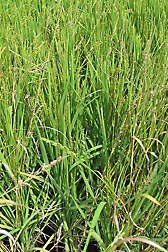This page has been archived and is being provided for reference purposes only. The page is no longer being updated, and therefore, links on the page may be invalid.
| Read the magazine story to find out more. |
|
|
|
|
New Rice Competes with Weeds, Offers High Grain Quality to Boot
By Jan Suszkiw
January 9, 2014..
Using conventional breeding methods, U.S. Department of Agriculture (USDA) scientists have developed a new rice cultivar that can hold its own against barnyardgrass and other costly weeds, opening the door to reduced herbicide use.
David Gealy and colleagues with USDA's Agricultural Research Service (ARS) and the University of Arkansas Division of Agriculture (UADA) at Stuttgart developed the new rice, STG06L-35-061, by crossing standard U.S. long-grain varieties with indica types from Asia. Indica rices are known for their ability to outcompete many weeds using allelochemical root secretions and other defenses. But these rice types haven't caught on in the United States in large part because of their poor grain quality, notes Gealy, with the ARS Dale Bumpers National Rice Research Center in Stuttgart.
Gealy, together with UADA rice breeder Karen Moldenhauer and ARS molecular geneticist Melissa Jia, tackled the problem by crossing two commercial tropical japonica rices, 'Katy' and 'Drew,' with PI312777, an indica germplasm line. They evaluated the offspring plants as part of multi-year trials that included comparisons to other rice crosses and chose STG06L-35-061 as the top pick for high grain yield and quality, early maturity, stem strength, pest and disease resistance, allelopathy to weeds, and other desirable traits.
The team's trials included evaluations of the new cultivar in both weed-free and weed-infested plots, with barnyard grass as the dominant weed species. Several commercial cultivars, including 'Lemont,' along with indica lines, were also tested.
During the trials, conducted in 2008 and 2009, weed-suppression ratings for the new cultivar were 41 percent higher than 'Katy,' 68 percent higher than 'Lemont,' and about equal to PI 312777. In weed-free plots, the new rice averaged about 5,000 pounds of grain per acre versus 5,400 for 'Drew;' 4,000 for 'Katy;' and 4,300 for 'Lemont.'
According to Gealy, the new rice's combination of traits will make it especially suited to organic and low-input production systems.
Read more about the rice in the January 2014 issue of Agricultural Research.
ARS is USDA's principal intramural scientific research agency.

